Late in April 1967, an unusual announcement was made by the Soviet news agency, Tass. A few days earlier, cosmonaut Vladimir Komarov had been launched into orbit aboard the new Soyuz spacecraft. In time, it was hoped that Soyuz would demonstrate rendezvous, docking, space station operations and possibly expeditions to the Moon. Chief Designer Sergei Korolev had dubbed Soyuz “the machine of the future” – an appropriate epithet, considering that its descendants are still operational today – and Komarov’s launch had been accompanied by a euphoric fanfare, for it was the first manned Soviet space mission in more than two years. Within a few short hours of launch, however, that euphoria turned into agony. In a few carefully crafted sentences, it was revealed that Soyuz 1 had “descended with speed” from orbit, due to “a shroud line twisting.” The devastating result, 45 years ago today, was “the premature death of the outstanding cosmonaut.” More than four decades later, details about the tragedy have steadily trickled into the Western consciousness…and they have revealed a harrowing disaster, still shrouded in myth, mystery and rumor.
The Soyuz Capsule: A Troubled Development
Despite Sergei Korolev’s genius, the development of Soyuz represented a quantum leap above his previous manned space vehicles, Vostok and Voskhod. By the spring of 1967, a year after the Chief Designer’s death, engineers struggled with more than 200 design problems, all of which were ignored by a political elite who kept up the pressure to get a cosmonaut back into space. The United States had flown ten Gemini missions and had made rendezvous, docking and spacewalking look easy. Now the American Apollo spacecraft was ready to fly its maiden voyage and it seemed that a Moon landing was within their grasp. It is said that Vladimir Komarov knew of the problems facing Soyuz 1, but admitted one night in March 1967 that he could not turn down the assignment, even though he was aware that his spacecraft was imperfect and his chances of returning alive were slim. His reason: Yuri Gagarin, the first man in space, was his backup. “If I don’t make the flight,” he told a close friend, Venyamin Russayev, “they’ll send the backup pilot instead. That’s Yuri, and he’ll die instead of me. We’ve got to take care of him!”
During the course of 1966, the Soviets had flown a number of unmanned Soyuz demonstration missions, under the cover name of ‘Cosmos’, and these revealed problems with docking systems, parachutes, hatches and environmental controls. Cosmos 133 in November 1966 suffered a malfunction with its attitude-control system, whilst Cosmos 140 in February 1967 reentered the atmosphere at too steep an angle, which caused a 300 mm hole to be burnt into its heat shield. Ironically, this burn-through was the only reason that the parachutes deployed properly…a worrisome portent of the calamity which which engulf Komarov a few months later. The Cosmos 140 descent module – of the same design to that which would house the cosmonaut – hit the frozen Aral Sea and was finally recovered by divers in 10 m of water. The judgement? The mission had been “good enough” for Komarov to be cleared to fly…
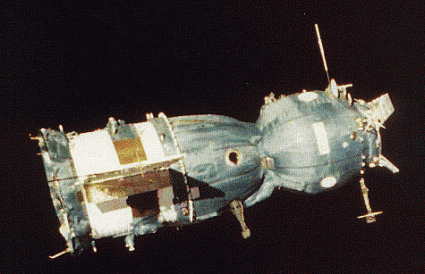
The early Soyuz spacecraft, showing the cylindrical instrument section at left, the spherical orbital module at right and the descent module – which carried the cosmonaut – in the centre. Vladimir Komarov’s craft was of similar design. – Credits: Roscosmos
Cleared To Fly: Framed By The Soviet Propaganda Machine
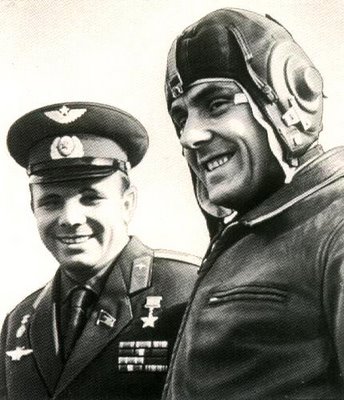
Vladimir Komarov (right) knew that he had to fly Soyuz 1…because his backup was the first man in space, Yuri Gagarin (left), a national hero, who had to be protected. Ironically, both men would die within a year of each other. Credits: Roscosmos.
The Soviet propaganda machine allowed much speculation to fester about the capabilities of Soyuz. On 19 April, Reuters quoted stories circulating in Moscow that two Soyuz would be launched on the 23rd and 24th and that the pair would rendezvous, dock and exchange crew members by means of EVA. Other tales told of five or six cosmonauts being launched in two ships. Still more suggested that the two Soyuz would remain docked for up to three days and – according to Time magazine on 5 May – there were some who were convinced that one of the craft had “a restartable engine that would push the joined ships as far out as 50,000 miles.” The idea of rendezvous, docking and EVA were accurate and it would appear that Soyuz 2, with cosmonauts Valeri Bykovsky, Alexei Yeliseyev and Yevgeni Khrunov, would have followed Komarov into orbit, rendezvoused and docked. Then, Yeliseyev and Khrunov would have spacewalked over to Soyuz 1 and returned to Earth in Komarov’s craft. Bykovsky would return alone in Soyuz 2. The other inaccuracies surrounding the mission, however, served only to highlight Western uncertainties about the Soviets’ intentions.
In fact, the very idea of transferring two men by EVA from one Soyuz to another had troubled engineers for months. The hatch in the spacecraft’s spherical ‘orbital module’, for example, was much too small – just 66 cm in diameter – for a fully-suited cosmonaut to easily pass through. This was particularly troubling, since the Soviets’ only previous EVA experience, in March 1965, had seen Alexei Leonov battle with a ‘ballooning’ suit, which almost prevented him from getting back inside his ship. Redesigning the Soyuz hatch would take months, so it was decided to transfer the cosmonauts’ oxygen supplies from a backpack to a ‘waist pack’. Photographs published during the Gorbachev era of glasnost (openness) revealed Komarov training with the Soyuz 2 crew and Yeliseyev and Khrunov were clearly shown wearing EVA suits. Komarov’s main duty would be to dock his craft with Soyuz 2 and much debate raged in the days before launch over whether this should be automatic or under manual control. Komarov was adamant that he could guide Soyuz 1 to docking, by hand, from a distance of 200 m, but the final consensus was an automated approach to 50 m.
With the joint flight scheduled for the end of April 1967, there was no mistaking its political significance, coming as it did in the 50th anniversary year of the Bolshevik Revolution and at a time when Soviet General Secretary Leonid Brezhnev was attending a major summit of the Eastern Bloc in Czechoslovakia. The opportunity for him to crow about yet another “socialist triumph” would be priceless.
Tragedy Unfolding
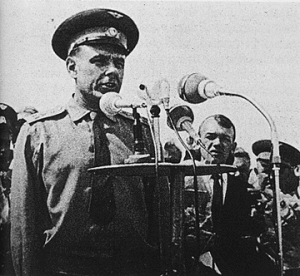
Vladimir Komarov was one of the oldest members of the inaugural cosmonaut selection in March 1960 and became the first cosmonaut to record two space missions. In terms of his education and training – he was an aircraft test engineer and rose to become a colonel in the Soviet Air Force – Komarov was by far the most qualified…an ideal candidate to command the first flight of Soyuz. Credits: Roscosmos.
Despite the misgivings, Soyuz 1 roared into space at 3:35 am Moscow Time on 23 April 1967 and quickly entered a satisfactory orbit of around 220 km. Four and a half hours later, the Soviet news media announced the successful launch and reported that the flight was proceeding normally. A second update at 10:00 am brought similar good news.
Then, 12 hours later, came the third update. Its words were shocking. Not only had there been no Soyuz 2 launch, but, devastatingly, it were revealed that Vladimir Komarov had died during reentry. In their truncated report, the Soviets alluded to Soyuz 1’s “very difficult and responsible braking stage in the dense layers of the atmosphere” and concluded that a “tangling of the parachute’s cords” had caused the craft to fall “at a high velocity,” which had ended in the cosmonaut’s death. Twenty years later, historian Phillip Clark wrote of “persistent reports” that the problems with Soyuz 1 arose within hours of reaching orbit. He noted that one of the ship’s solar arrays failed to open properly, depriving Komarov of more than half of his power supply (some sources say up to a 75 percent reduction in electrical capability). The result was a shortened mission of barely 24 hours.
A backup telemetry antenna also failed, probably leading to sporadic reception, and glitches with solar and other sensors meant that the cosmonaut could not even maintain effective control over his orientation. (It later became clear that the solar sensor had been contaminated by Soyuz 1’s thrusters.) The antenna failure was a minor irritation, but the orientation sensor problems were far more serious, for they made it virtually impossible to dock with Soyuz 2. Komarov tried to visually orient his craft, using Earth’s horizon, with no success. With only one solar array “wing” deployed, Soyuz 1 had assumed an asymmetrical shape, making orientation even harder. The cosmonaut was even obliged, at one stage, to knock his boots on the side of the spacecraft in a fruitless bid to free the stubborn deployment mechanism for the stuck solar array.
By now, Bykovsky, Yeliseyev and Khrunov’s launch on 24 April had been cancelled and planning got underway to bring Komarov safely back to Earth.
Attempts to perform a de-orbit retrofire were made on Soyuz 1’s 16th, 17th and 18th circuits of the globe and were frustrated by an inability to control the ship’s orientation. In Starman, Piers Bizony and Jamie Doran wrote that Komarov raged at “this devil ship” and complained that “nothing I lay my hands on works properly.” Unlike earlier Vostoks, the Soyuz descent module was not spherical, but had a distinctly flattened base and an offset centre of gravity to provide greater aerodynamic “lift” during reentry. Unfortunately, it also required more precision as it began to encounter the upper atmosphere, and with an ineffective attitude-control system, this was virtually impossible to achieve.
The first retrofire attempt began at 2:56 am on 24 April, but the orientation problems caused Soyuz 1’s automatic control system to halt it. A decision was made to cancel the attempt on the 17th orbit and use that pass instead to plan for another try on the 18th. At some point between 3:30 am and 4:00 am Moscow Time, a Japanese station picked up radio signals from the ship and Tass reported that these were part of a “normal” communications event with mission controllers.
That event was far from normal.
– In the video below, a short Russian documentary about the ill-fated Soyuz 1 mission.
[cleveryoutube video=”hw56mLN2Ezc” vidstyle=”1″ pic=”” afterpic=”” width=”” quality=”inherit” starttime=”” endtime=”” caption=”” showexpander=”off” alignment=”left” newser=””]
Aware Of His Fate
Five years later, in August 1972, an analyst from the United States National Security Agency, under the pseudonym of Winslow Peck (his real name was Perry Fellwock) reported that he had been on duty at a listening post near Istanbul, in Turkey, on the night of Soyuz 1’s re-entry. According to Fellwock, both controllers and Komarov himself knew that his survival was unlikely and the cosmonaut even spoke to his wife, Valentina, and to Soviet Premier Alexei Kosygin. In the exchange, Komarov told his wife how to handle his affairs and what to do with their children. “It was pretty awful,” Fellwock concluded. “Towards the last few minutes, he was falling apart.”
These and other harrowing – though unverified – accounts suggest that the cosmonaut had some awareness that the problems he faced were insurmountable. Unconfirmed stories over the years hinted that, when re-entry finally got underway, Komarov grumbled that “the parachute is wrong” and that “heat is rising in the capsule.” Descending on his 18th orbit, the re-entry orientation was far from perfect, in light of the asymmetrical shape of Soyuz 1 and its inability to execute effective attitude control. Still, the retrofire began at 5:59 am Moscow Time and ran for long enough to ensure entrance into the upper atmosphere. Thirteen minutes later, the Yevpatoriya control station in the Crimea picked up voice communications from the spacecraft, in which Komarov apparently advised them of the results of the retrofire and his loss of attitude control. Communications then fell silent as Soyuz 1, sheathed in super-heated plasma, entered a period of radio blackout.
During reentry, the descent module, carrying Komarov, should have separated from the remainder of the Soyuz – the orbital module and instrument module – about a dozen minutes after retrofire. This would have been followed, some 14 minutes later, by the deployment of the parachutes and touchdown in the Soviet Union around 25 minutes after that. Sometime between 6:18 am and 6:20 am, Komarov’s voice seemed calm and unhurried, in spite of the 8G load imposed by the steep, ballistic reentry. Notwithstanding these problems, Soyuz 1 might still have landed safely.
Then its parachutes failed.
– In the video below, a reconstruction of the parachute failure that doomed Vladimir Komarov and Soyuz 1.
[cleveryoutube video=”OOXKsCzJyLQ” vidstyle=”1″ pic=”” afterpic=”” width=”” quality=”inherit” starttime=”” endtime=”” caption=”” showexpander=”off” alignment=”left” newser=””]
Falling To The Ground
Komarov’s fellow cosmonaut Alexei Leonov was in the control centre at the time. In his autobiography, Two Sides of the Moon, he noted that although a drogue chute deployed successfully, the latter failed to pull the main canopy out of its storage canister. Although a reserve parachute was jettisoned, it became entangled with the cords of the drogue and also failed to open. Indeed, Soyuz 1’s point of impact – at 51.13 degrees North latitude and 57.24 degrees East longitude, some 65 km east of the city of Orsk, in the southern Ural Mountains – was much further west than normal. This prompted many Western analysts to conclude that these landing coordinates were “consistent with a purely ballistic reentry…and no parachute deployment.” In the hinterland around Orsk, locals who witnessed the final stages of Komarov’s descent reported seeing Soyuz 1’s parachutes simply turning and not filling with air.
Soviet anti-aircraft radar had detected the incoming spacecraft at 6:22 am and predicted its landing a couple of minutes later. Listening posts in Turkey are said to have intercepted Komarov’s cries of rage and frustration as he plunged to his death, cursing the engineers and politicians who condemned him to flying a fault-ridden ship. Whether such words were ever spoken can never be known. What is known, however, is the sheer horror which followed. Traveling at more than 640 km/h, Soyuz 1 hit the ground with the unbridled passion of a meteorite, killing Komarov instantly and completely flattening the capsule. Solid-fuelled rockets at its base – meant to fire, just before touchdown, to cushion the landing – actually detonated on impact and the remains of the craft burst into flames.
– In the video below, the last words of Vladimir Komarov during his tragic descent.
[cleveryoutube video=”3Z_m7onLw74″ vidstyle=”1″ pic=”” afterpic=”” width=”” quality=”inherit” starttime=”” endtime=”” caption=”” showexpander=”off” alignment=”left” newser=””]
Soon, the whole site was engulfed in black smoke and it did not take long for the first helicopter rescue pilot on the scene to judge that it was a fatal situation. Yet he could not say so over an open communications loop, lest word escape to the outside world. Instead, he reported that “the cosmonaut is going to need emergency medical treatment outside the spacecraft”. And on this misleading call there hangs quite a tale. Flight surgeons Oleg Bychkov and Viktor Artamoshin were both members of the search and rescue group and they reported that their helicopter touched down less than a hundred metres from the point of impact. They realised, in their own words, that “the pilot would no longer need help.” By now, the blaze was of such ferocity that the base of Soyuz 1 had completely burned through and streams of molten metal were rolling across the barren landscape. The would-be rescuers were carrying flares, to signal the overhead aircraft, but no code existed to denote the death of the cosmonaut…so they were obliged to fire the one that equated to Komarov needing medical assistance. For a time, this kindled some hope that he had survived.
Not only had Komarov been killed, but there remained very little of his mortal form left. Portable fire extinguishers were useless against the inferno and the rescuers were forced to shovel clods of earth onto the remains in an attempt to dampen down the flames. The height of the descent module, normally about 2 m, had shrunk to a shriveled mess, no taller than 70 cm! As they continued to fight the fire, this ruin collapsed, leaving nothing but a heap of smoldering wreckage, a couple of pools of molten aluminium and, on top of it all, Soyuz 1’s circular entrance hatch. Komarov’s remains were “excavated” from what was left of his ship; his cause of death would later be attributed to massive multiple injuries to the skull, spinal cord and bones. Eyewitnesses recounted that the cosmonaut’s body had been reduced to a ‘lump’, 30 cm wide and 80 cm, whilst some observers noted that a heel bone was the only extant, recognizable fragment…
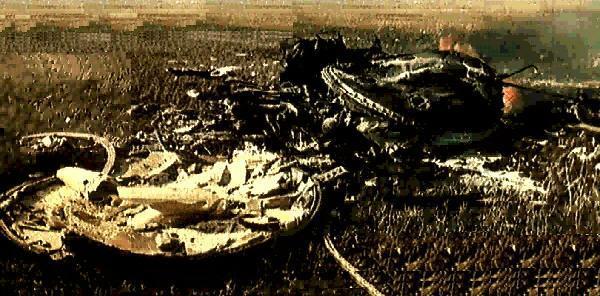
One of few images of the Soyuz 1 crash site ever to be released in the post-Soviet era. Somewhere in the midst of this burning mass of twisted metal lay the remains of the first man to die during a space mission. Credits: Roscosmos.
Investigation And Legacy
An investigation, headed by V.V. Utkin of the Flight Research Institute of the Aviation Industry, revealed that Soyuz 1’s parachute container had opened at an altitude of 11 km, but had become “deformed.” This had squeezed the main canopy and thus prevented it from opening correctly. Although the small drogue chute had emerged, the main canopy simply could not exit the container…but not just because of the deformation. The drogue was designed to impart a force of 1,500 kg to pull out the main canopy, but it actually required upwards of 2,800 kg to be effective, perhaps due to the effect of air pressure in the descent module pushing against the container. Although these problems had never arisen in ground tests, Utkin’s panel determined that the “abnormal” and “random” conditions of Soyuz 1’s reentry had conspired against it. Future missions would benefit from enlarged and strengthened parachute containers.
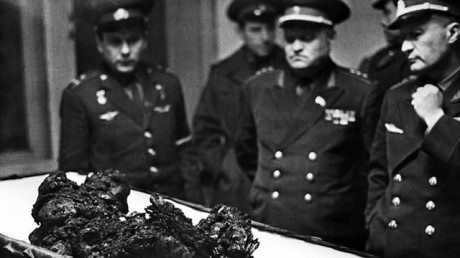
This image from the Soviet archives purportedly shows the mortal remains of Cosmonaut Vladimir Komarov. Credits: Roscosmos.
Yet there is one final, chilling, part to the story. Had Soyuz 1 succeeded, it is certain that Soyuz 2 would have followed on 24 April, with cosmonauts Bykovsky, Yeliseyev and Khrunov. In his seminal work Challenge to Apollo, Asif Siddiqi explained that both Soyuz 1 and 2 were coated with thermal protection materials during their pre-launch preparations and inserted into high-temperature chambers for testing. Both were then subjected to a punishing sequence of tests, with their parachute containers in place, but lacking covers. The consequence was that the interiors of both craft’s parachute containers acquired a polymerised coating, which formed a very rough surface and contributed to the failure of Soyuz 1’s parachute deployment. Shockingly, it would have had the same effect on Soyuz 2. “The most chilling implication of this manufacturing oversight,” wrote Siddiqi, “was that both Soyuz spacecraft were doomed to failure. That is, if Komarov had not faced any troubles in orbit and the Soyuz 2 launch had gone on as scheduled, all four cosmonauts would have died on return.”
Forty-five years ago, this week, the Soviet Union seemed to be in pole position to beat America to the Moon. In January 1967, three astronauts had died during a fire on the launch pad and with Soyuz 1 it was eagerly hoped that Russia could recoup some lost ground. The Soyuz spacecraft would be modified, would fly its first fully successful piloted mission in October 1968 and its descendants would fly rendezvous and docking and support no fewer than nine orbital space stations – including today’s International Space Station – but the events of that terrible April in 1967 would forever haunt the Soviet space program. The grand plans for the first Soyuz missions, including a ship-to-ship EVA transfer, would be successfully demonstrated in January 1969…but by then, American astronauts had already circled the Moon and yet another dreary propaganda stunt by the Soviets was recognized for what it was. The loss of Soyuz 1 was a crushing setback of such severity that it directly impacted Russia’s last chance to beat America to the Moon, but the problems which it uncovered – and which demanded resolution before it could fly again – ultimately turned the craft into one of the safest and most long-lived space vehicles in history.
Surely that is a fitting memorial to Cosmonaut Vladimir Komarov.
– By Ben Evans. This article was originally published in AmericaSpace. It is republished with permission of the author and editor.

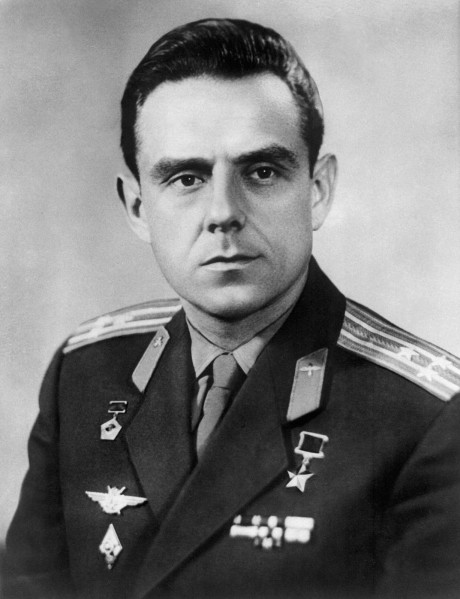

















![A trajectory analysis that used a computational fluid dynamics approach to determine the likely position and velocity histories of the foam (Credits: NASA Ref [1] p61).](http://www.spacesafetymagazine.com/wp-content/uploads/2014/05/fluid-dynamics-trajectory-analysis-50x50.jpg)



I do not understand the film purporting to carry Komorov’s last words. Is that an actual recording of the last communications between the spacecraft and ground control, or is it a “dramatic recreation”? If the latter, what is it based on? In either case, could English subtitles or a transcript be provided?
What do you want as the last words of an intelligent and highly trained man who is in the trap of his politicians? “You sons of bitches !!” ?? Now let each one have his heart in peace and acknowledge the bravery of this man. R.I.P. Great Vladimir Komarov.
The “Komorov’s last words” video is complete and utter balderdash.